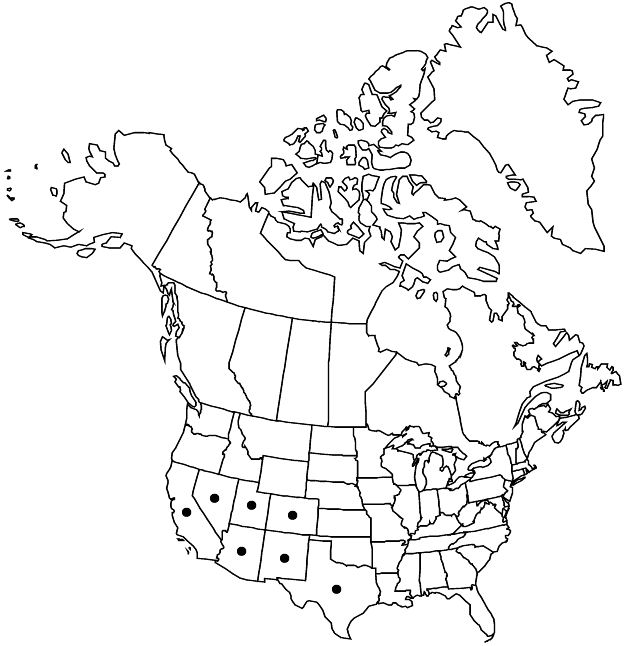Euphorbia revoluta
Rep. U.S. Mex. Bound. 2(1): 186. 1859.
Herbs, annual, with slender taproot. Stems erect, 5–25 cm, glabrous. Leaves opposite; stipules distinct, subulate-filiform, entire, 0.5–0.9 mm, glabrous; petiole 0.6–1.1 mm, glabrous; blade linear, 6–27 × 0.6–1.2 mm, base symmetric, attenuate, margins entire, revolute, apex acute, sometimes mucronate, surfaces glabrous; only midvein conspicuous. Cyathia solitary at distal nodes; peduncles absent or to 1.5 mm. Involucre obconic to campanulate, 0.7–0.9 × 0.5–0.7 mm, glabrous; glands 4, pink to dark purple, nearly circular to oblong or reniform, 0.1 × 0.1–0.2 mm; appendages white, oblong, nearly circular, ovate, deltate, or forming thin margin around gland, rarely absent, (0–) 0.1–0.2 × (0–) 0.1–0.3 mm, distal margin entire. Staminate flowers 5–10. Pistillate flowers: ovary glabrous; styles 0.2–0.3 mm, unbranched. Capsules ovoid to subglobose, 1.5–1.8 × 1.6–1.8 mm, glabrous; columella 1.1–1.5 mm. Seeds whitish, brick-red, light gray, or light-brown, narrowly to broadly ovoid, 4-angled in cross-section, 0.9–1.4 × 0.7–1 mm, nearly smooth, rugulose, with faint transverse ridges, or with 2–3 well-defined transverse ridges separated by shallow depressions.
Phenology: Flowering and fruiting summer–late fall.
Habitat: Desert scrub, sagebrush scrub, juniper woodlands, Joshua tree-pinyon pine woodlands, oak woodlands, grasslands, chaparral, pine-oak forests.
Elevation: 600–2500 m.
Distribution

Ariz., Calif., Colo., Nev., N.Mex., Tex., Utah, Mexico (Baja California), Mexico (Chihuahua), Mexico (Coahuila), Mexico (Sonora), Mexico (Zacatecas)
Discussion
Euphorbia revoluta is a distinctive, easily recognizable species by virtue of the combination of unbranched styles and linear leaves with symmetric bases. The species ranges through northern Mexico into the southwestern United States and is composed of three well-marked, geographically distinct races that can be distinguished by their seeds. The first of these races occurs primarily in pine-oak forest of the Sierra Madre Occidental of Mexico (Chihuahua and Sonora) and barely enters the flora area in the Huachuca Mountains of southeastern Arizona; the seeds are brick red and nearly smooth. The second race is widespread in the Chihuahuan Desert from northern Mexico to southeastern New Mexico and southwestern Texas; its seeds are whitish to light gray and possess two or three well-defined transverse ridges separated by shallow depressions. The third race corresponds to the type collection and is characterized by grayish white to light brown seeds that are rugulose or with faint transverse ridges; it occurs in northwestern Mexico (Baja California and Sonora) and throughout the arid southwestern United States. It is probable that further study will justify the taxonomic segregation of these races as either distinct species or subspecies.
Selected References
None.
Lower Taxa
"connate" is not a number. "distinct" is not a number."connate" is not a number. "distinct" is not a number.